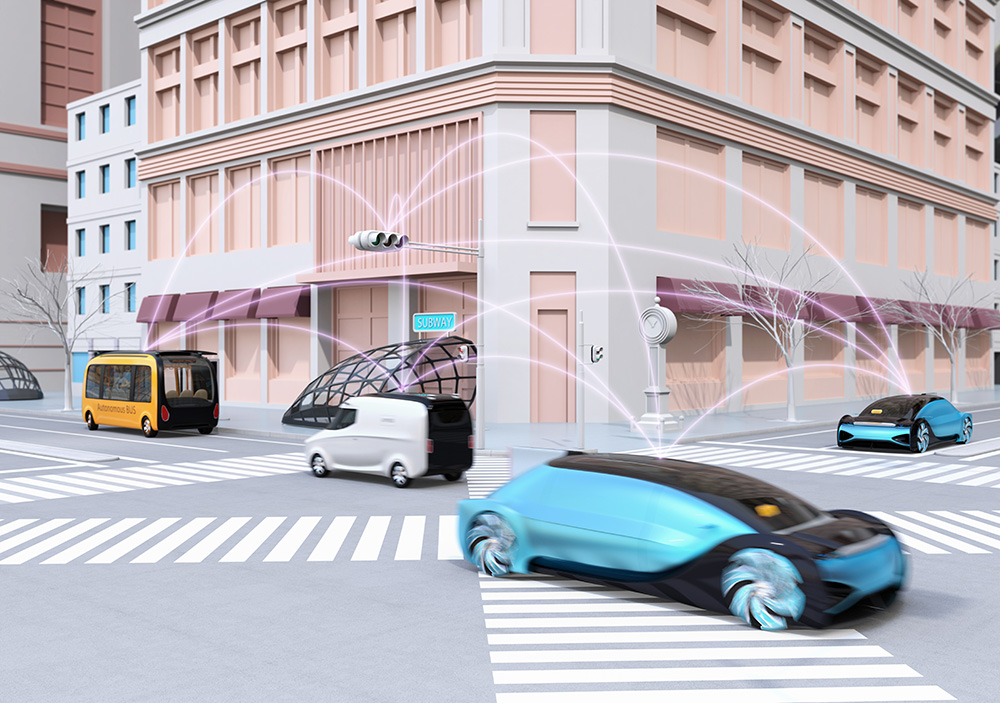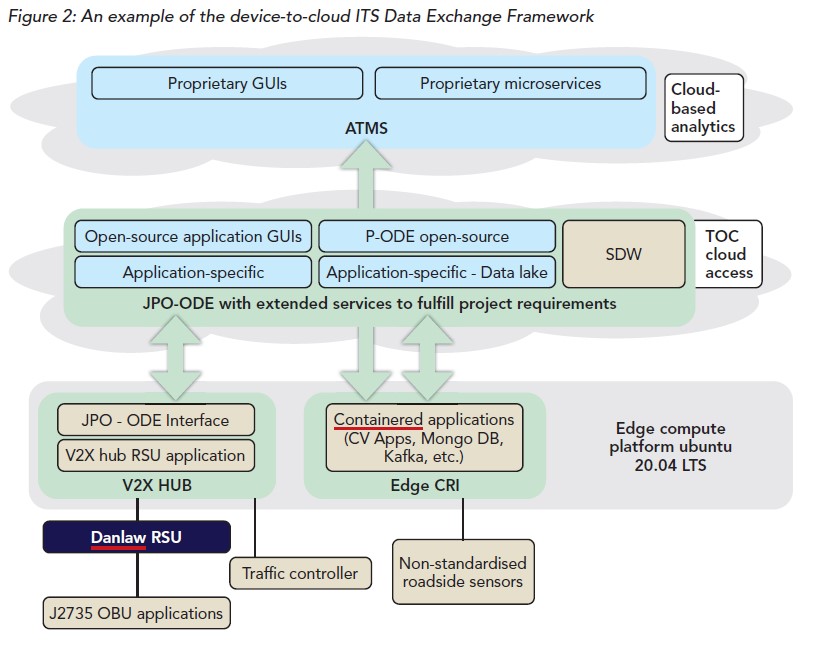
A new era in traffic control enabled by emergent technologies is upon us. The datasets available by these technologies can help revolutionise traffic management methods only if infrastructure owner operators (IOOs) are able to leverage the data, applying the actionable information within an intelligent transportation system.
However, the advancement of new roadway technologies has outpaced the industry’s ability to standardise the data exchange and management, creating a standards gap. An unfortunate consequence of this growing gap is an increased proliferation of proprietary data and control systems. Collaborative efforts are underway to establish a referential open-source platform as a proposed addition to our National ITS Architecture.1 Implementing an open-source ITS architecture for a connected and automated vehicle (C/AV) environment can provide a more agile framework that helps overcome systemic challenges within the National ITS Architecture. It can also help accelerate the deployment and extensibility of new ITS and C/AV solutions.
Overview of the ITS project
The Innovate Mound project, located in Macomb County, Michigan, US, involves the reconstruction of a nine-mile stretch of Mound Road between Interstate 696 and Highway 59. The goal is to transform the roadway into a smart corridor that includes the deployment of emerging mobility technologies that will enhance safety, optimise efficiencies and help future-proof the multimodal corridor.
Another objective is to make it a showcase for the implementation of diverse data-driven traffic management strategies, C/AV technologies, advanced software, automation and scientific techniques. Key to this is featuring public and private partnerships to deliver a system concept that can be extended on a large scale, including neighbouring states. Ultimately, the design and implementation of an open-source framework seeks to overcome systemic technology and data-management standards challenges within the US Department of Transportation’s National ITS Architecture and to provide an innovative solution that is extensible and capable of being deployed on a national scale.
Innovate Mound public partners include Macomb County, Macomb County Department of Roads (MCDR), the City of Sterling Heights, the City of Warren, Federal Highway Administration (FHWA), Michigan Department of Transportation (MDoT), and the Southeast Michigan Council of Governments (SEMCOG). These partners provide overall administration, coordination, project assistance, and act as a technical oversight committee (TOC).
The risk of proprietary solutions
Generally, ITS procurements for software systems can place operational requirements at levels of increasing solution specificity described as follows:
- Functional: Requirements placed on software end functionality, without constraint upon the software design.
- Modular: Requirements placed on modularity and interconnectedness of software components via industry-standardised interfaces - e.g. National Transportation Communications for ITS Protocol (NTCIP) - of the end system but do not offer much to constrain the internal design of each module
- Architectural: Requirements placed on software architecture, source code and toolchains for the greatest specificity of solution.
Early ITS software procurements focused primarily on end-user functionality. As a result, during the personal computer revolution of the 1980s and 1990s, the ITS industry evolved toward deployment of proprietary solutions that did not offer extensibility or cross-vendor integration. While those deployments provided an immediate ITS capability, they were later found to be constrained with proprietary data interfaces that did not allow for interoperability with technologies and systems installed later. Fortunately, in the late 1990s, work through the NTCIP standardisation released the National ITS Architecture from this proprietary binding.
Current state of play
Public agencies, private industry, and transportation research communities have been collaborating for more than 30 years toward a common goal of the design and deployment of a standardised National ITS Architecture using NTCIP as the means of ensuring cross-vendor modularity of subsystems. The guiding objectives of this design were focused on device interoperability via standardisation of data interfaces between roadway users, management centres, vehicles and infrastructure field devices.
Recent deployments of C/AV-based systems have revealed a significant gap between National ITS Architecture version 5 and the forthcoming generation of new field devices, crowd-sourced datasets, cloud-hosted analytics, and other technologies (see Figure 1, right). Newer technologies promise to improve roadway safety and mobility, but only if these technologies can be given access to existing ITS systems and vice versa.
Newer deployments of ITS/C/AV solutions have been encumbered by these NTCIP interfaces and cannot implement many of the capabilities of newer ITS technologies to improve safety and mobility, largely due to data exchange incompatibilities because of data management and communications constraints of legacy standards. Unfortunately, change for these standards cannot keep pace with emergent technologies, leaving a significant ITS standards gap. What can be done to stave off another era of proprietary systems?

Open-source architecture: mitigating the risk
The transportation industry must remember the lessons learned in the 1990s. The emergence of new data-driven ITS capabilities are not necessarily developed with the underlying standards and policies needed to apply these technologies consistent to the National ITS Architecture. Open-source cloud-based architecture is an answer. An open-source architecture offers the same collaborative openness as standards, but can move faster, and be more responsive to change. Currently, there is not a mandated open-source cloud architecture within the National ITS architecture. However, a reference architecture is currently being fostered by the USDoT’s Joint Program Office (JPO) through several open-source programs. A community of practice has been established to develop and study a new reference architecture based upon developing a set of open-source, containerised microservices platforms.
Innovate Mound project
Following an open-source platform approach for the Innovate Mound project, an ITS solution was developed. It verifies intent and refines the requirements as required to build upon an open framework and open-source architecture that is composed of several USDoT and FHWA projects.
This will see the output of the Innovate Mound program uniquely contributing to the emergent FHWA-led GitHub repositories that are currently expanding to replace the prior ‘modular’ National ITS Architecture. The core solution will be open-sourced, offering these advanced solutions on a national scale.
Moreover, Macomb County and MDoT will be able to leverage services from other ITS data exchanges being developed within these open-source programs (e.g. Carma Streets) and continue to expand the breadth, capabilities, and inclusiveness of this system.2 This ITS solution seeks to support C/AV applications that vehicle OEMs can easily apply within their vehicles’ operating systems.
These data elements encompass very complicated datasets that cannot be simply characterised by a brief description or reference to existing standards. There are underlying standards, data transformations, data integrity methods, infrastructural requirements, accuracy expectations and many other factors that must be considered before utilising this data in any in-vehicle safety system.
The intent is to develop a set of open-source microservices that provide absolute clarity of these data transformation methods, as well as establish an extensible solution that the transportation industry can update as new edge devices, data transformation methods, and other technologies arise.

ITS data exchange overview
The software framework, as well as several C/AV applications that demonstrate the capabilities of this collective system, has been designed to support the following ITS data exchange and software application elements for the Innovate Mound project.
The software architecture was designed to provide the data exchange between each of the applications noted in Table 1, as well as any edge computing and cloud processing. A high-level working design documentation has been drafted as part of the project to provide Macomb County with an opportunity to review and influence the intended design, as well as form the framework for existing and new project partners in the design, development, integration, deployment, training and testing of this ITS software system.
Open-source containerised micro-service-based ITS architecture
Taking into consideration the applications and data exchange requirements, the architecture being implemented follows the FHWA architecture guidance offered through the FHWA open-source GitHub repositories.
To develop and deploy a software framework based upon the USDOT open-source data management for the project, the ITS data exchange architecture seen in Figure 2 (above, right) was designed and implemented.
This containerised microservice-based framework offers edge (V2X Hub.3), cloud computing platforms (JPO-ODE.4), and situational data warehouses (SDW) where the
C/AV applications can reside. This architecture also enables a mixing of platforms, where some applications may have elements best hosted at the edge level and other elements best hosted in the cloud.

Summary
The open-source containerised microservice-based architecture developed for the Innovate Mound project was designed to provide a framework that overcomes the current systemic challenges of the National ITS Architecture to help accelerate the deployment and extensibility of new ITS and C/AV solutions while avoiding the historical pitfalls of proprietary-based solutions of the previous ITS eras.
It was also designed to leverage standardised interfaces wherever possible. The system architecture is highly modular, leveraging the current NTCIP and SAE interfaces supported within the National ITS Architecture.
It separates functional elements via Center-to-Center (C2C) and NTCIP 1211 dialogues. This provides built-in expandability and ITS data exchange agility to help ensure interoperability with any vendor’s traffic controllers, advanced transportation management system (ATMS) and transit management system.

With the underlying goal to mitigate the risks of proprietary system binding, the open-source architecture and framework is also designed to easily integrate and interface with future traffic control capabilities, including the anticipated datasets that will be produced from situational awareness and cooperative perception solutions, incorporating trajectory-aware and tracking-based sensing.
The architecture’s ITS data exchange framework also applies NTCIP and SAE standard dialogues, including extensions developed to support emergent C/AV and Smart City applications and environments.





